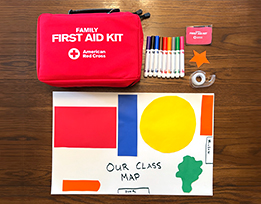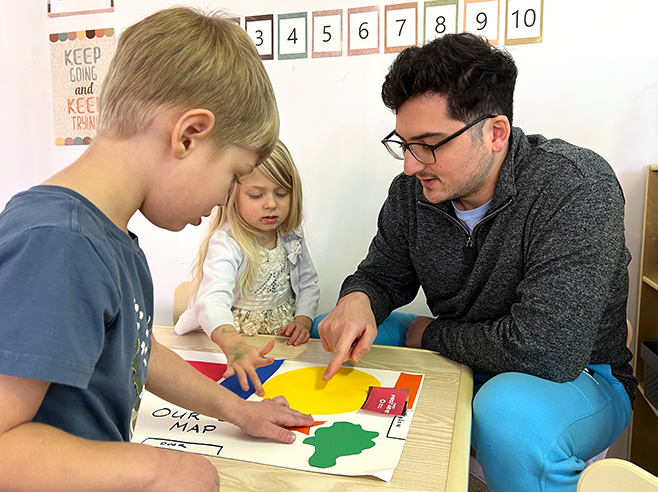Children use the classroom map during a pretend “emergency.”
Materials

- The big classroom map from the Circle Time activity (preferably laminated)
- Picture of a first-aid kit (You can draw this yourself or print an image from the internet.)
- A real or toy first-aid kit
- Sticker of a star, or a paper star
- Washable markers
- Tape
Preparation
- On your big classroom map, tape the star on a landmark (the block area, for example). This is the starting point for children.
- Add the picture of a first-aid kit to the classroom map, placing it as far away from the star as possible.
- Put the “real” first aid kit near the “real” landmark in the classroom.
- Gather children at the starting point in the classroom (where the star is located on the map).
Directions
- Set the scene. Use the story below, or create your own: Children are playing in the block area, when somebody falls and scrapes a knee. Oh-oh! Quick! To the rescue! Get the first aid kit! What’s the shortest route to get there?
- Help children locate the star (the starting point) and the first aid kit on the map.
- Then help them locate the starting point (where they are standing) and the location of the first-aid kit in the classroom.
- If your classroom map is laminated, draw two routes on the map from the star to the first aid kit. If your map isn’t laminated, trace the two routes with your finger. Ensure that one route is significantly longer than the other. One route might go straight to the first-aid kit; the other might wind around several landmarks before ending at the first-aid kit.
- Ask children: Quick! Which is the shortest route to the first-aid kit? This route or that route? Ask them why they chose one over the other.
- Next, have one or two children test the length of each route. As they walk to the first aid kit, the rest of the group counts the number of steps it takes to reach the first-aid kit. Write the number of steps next to their route on the map (or on a separate piece of paper). Do the same with the other route. The number of steps does not need to be exact, and it’s okay if you miss a few steps. If the two routes are very close, you can do a recount.
- When children have finished walking and counting their routes, ask:
- Which route was the shortest? How do you know?
- How many steps did the shortest route take? Is that the route you thought would be the shortest?
- Pretend you don’t know where the first-aid kit is. How can a map help you find it?
